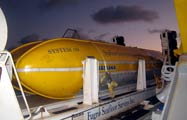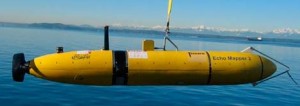I joined Fugro Seafloor Surveys, Inc. (FSSI) as a sea-going Ocean Engineer to support the engineering operations and maintenance of the company’s underwater mapping equipment. My tenure with FSSI had me performing a wide range of jobs from ocean deployments to ship mobilizations to electronic design and troubleshooting. However, most of my time with the company had me integrated with the Research and Development team making a new Autonomous Underwater Vehicle (AUV) operational.
 Before joining FSSI I had no prior experience working with underwater sonar systems. With a degree in physics, practical laboratory experience, and a knack for solving problems I was able to come to speed quickly. I soon had experience working on and operating both of the older towed systems, the Sys9 and Sys100D. These were both great platforms to learn on, exposing me to electronic considerations in pressure vessels, the robustness needed in an operational setting at sea, and the theory and practice sonar imaging and mapping.
Before joining FSSI I had no prior experience working with underwater sonar systems. With a degree in physics, practical laboratory experience, and a knack for solving problems I was able to come to speed quickly. I soon had experience working on and operating both of the older towed systems, the Sys9 and Sys100D. These were both great platforms to learn on, exposing me to electronic considerations in pressure vessels, the robustness needed in an operational setting at sea, and the theory and practice sonar imaging and mapping.
Echo Mapper II AUV
 After learning the basics of sonar mapping I was embedded in the R&D team that was bringing the company’s new Bluefin 21 AUV operational.Together we succeeded in making the AUV operational for client’s project and afterward worked through additional problems that crept up during the project. The following is a detailed look into some of the aspects of the AUV I spearheaded or was involved with:
After learning the basics of sonar mapping I was embedded in the R&D team that was bringing the company’s new Bluefin 21 AUV operational.Together we succeeded in making the AUV operational for client’s project and afterward worked through additional problems that crept up during the project. The following is a detailed look into some of the aspects of the AUV I spearheaded or was involved with:
Endurance Testing
With only two other people in the R&D department I became intimately familiar with the planning and operations of the device. I was soon planning the mission, launching the device and chase boat, directing operations from the chase boat, and the initial data handling. Should a glitch or fault cause the mission to be aborted I had the responsibility to either find a solution or bring the device safely back to dock.
Accurate Timing Source
It is necessary to know the time accurately to determine the position accurately as well. This has been true throughout history and has not changed with the advent of the AUV. On the surface the device utilized GPS time to synchronize itself, but once it dove below the waves this stable timing source disappears. For the early short missions this was not a huge problem, but as the mission durations increased, so too did the severity of the issue.
As a result I was tasked with adding a highly stable and accurate timing source on the AUV and making the three computer systems on-board synchronize to it. I choose a Rubidium clock and designed a system that would synchronize it to GPS time when it was on the surface. Once the AUV went underwater the Rubidium clock would provide a stable time source to the three computers on-board. A log file was also created once it surfaced again to log any drift between the rubidium clock and GPS time to aid with the post processing of the sonar data.